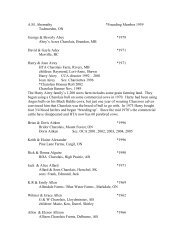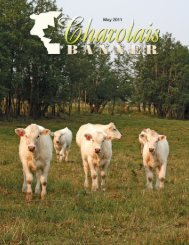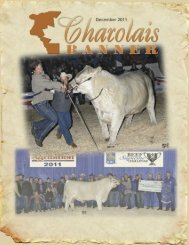You also want an ePaper? Increase the reach of your titles
YUMPU automatically turns print PDFs into web optimized ePapers that Google loves.
Calf losses at calving time are often<br />
a result of dystocia (difficult calving)<br />
problems. Many of these losses occur<br />
to calves born to first calf heifers and<br />
can be prevented if the heifers and<br />
cows are watched closely and the<br />
dystocia problems detected and<br />
corrected early. A veterinarian should<br />
handle serious and complicated<br />
calving problems. Ranchers must use<br />
good judgment in their decisions as<br />
to which problems will require<br />
professional help, and the earlier help<br />
is sought the greater the survival rate<br />
of both cow and calf.<br />
Recognize Normal Calving<br />
If the calf is normally presented<br />
(Figure 1) and the pelvic area is large<br />
enough, the vast majority of animals<br />
will give birth without assistance.<br />
Recognizing a normal calving is just<br />
as important as knowing when a<br />
calving is abnormal. This way you<br />
will not give help when it is not<br />
needed.<br />
The Three Stages of Parturition<br />
Stage 1<br />
The first stage of parturition is<br />
dilation of the cervix. The normal<br />
cervix is tightly closed right up until<br />
the cervical plug is completely<br />
NEWS<br />
Calving Time Management<br />
for Beef Cows and Heifers<br />
Glenn Selk, Professor, Extension Animal Reproduction Specialist, Animal Science<br />
Dave Sparks, DVM, Area Food/Animal Quality and Health Specialist, Oklahoma Cooperative<br />
Extension Service<br />
dissolved. In stage 1, cervical dilation<br />
begins some four to 24 hours before<br />
the actual birth. During this time the<br />
progesterone block is no longer<br />
present and the uterine muscles are<br />
becoming more sensitive to all factors<br />
that increase the rate and strength of<br />
contractions. At the beginning, the<br />
contractile forces primarily influence<br />
the relaxation of the cervix but<br />
uterine muscular activity is still<br />
rather quiet. Stage 1 is likely to go<br />
completely unnoticed, but there may<br />
be some behavioral differences such<br />
as isolation or discomfort. Near the<br />
end of stage 1 ranchers may observe<br />
elevation of the tail, switching of the<br />
tail, and increased mucous discharge.<br />
Stage 2<br />
The second stage of parturition is<br />
defined as the delivery of the<br />
newborn. It begins with the entrance<br />
of the membranes and fetus into the<br />
pelvic canal and ends with the<br />
completed birth of the calf. The<br />
second stage is the one producers are<br />
really interested in because this is<br />
where all the action is. Clinically the<br />
onset of stage 2 is marked by the<br />
appearance of membranes or water<br />
bag at the vulva. The traditional texts,<br />
fact sheets, magazines, and other<br />
publications state that stage 2 in<br />
cattle lasts from two to four hours.<br />
Data from Oklahoma State University<br />
and the USDA experiment station at<br />
Miles City, Montana, would indicate<br />
that stage 2 is much shorter being<br />
approximately one hour for heifers<br />
and one-half hour for adult cows. See<br />
When and How to Examine a Cow<br />
on page 3. In heifers, not only is the<br />
pelvic opening smaller, but also the<br />
soft tissue has never been expanded.<br />
Older cows have had deliveries<br />
before and birth should go quite<br />
rapidly unless there is some<br />
abnormality such as a very large calf,<br />
backwards calf, leg back, or twins.<br />
Stage 3<br />
The third stage of parturition is the<br />
shedding of the placenta or fetal<br />
membranes. In cattle this normally<br />
occurs in less than eight to 12 hours.<br />
The membranes are considered<br />
retained if after 12 hours they have<br />
not been shed. Years ago it was<br />
considered necessary to remove the<br />
membranes by manually unbuttoning<br />
the attachments. Research has shown<br />
that manual removal is detrimental to<br />
uterine health and future conception<br />
rates. Administration of antibiotics<br />
usually will guard against infection<br />
and the placenta will slough in four<br />
to seven days. Contact your<br />
veterinarian for the proper<br />
management of retained placenta.<br />
Dystocia<br />
What is dystocia or a difficult<br />
birth? Traditionally, it is any birth<br />
that has needed assistance. According<br />
to that definition, any unassisted<br />
birth was a normal birth, but by the<br />
definition an unassisted birth could<br />
still result in weak or dead calf at<br />
birth. A more modern definition of<br />
dystocia would be a birth that needs<br />
assistance or results in a weakened or<br />
dead calf or injury to the dam.<br />
Causes of Dystocia<br />
What are the causes of dystocia?<br />
Most common is relative fetal<br />
oversize, which could be defined as a<br />
calf too big, pelvis too small, or both.<br />
As for calving difficulty, prevention<br />
is worth a pound of cure. Proper sire<br />
selection is a key to preventing<br />
calving difficulty. Underdeveloped<br />
heifers and heifers bred to bulls with<br />
large birth weights are both factors<br />
that cause increased incidence of<br />
difficult births. The second most<br />
prevalent cause is abnormal<br />
presentation or position. The normal<br />
presentation in cattle is anterior<br />
<strong>Charolais</strong> Connection • <strong>February</strong> <strong>2013</strong> 49

















